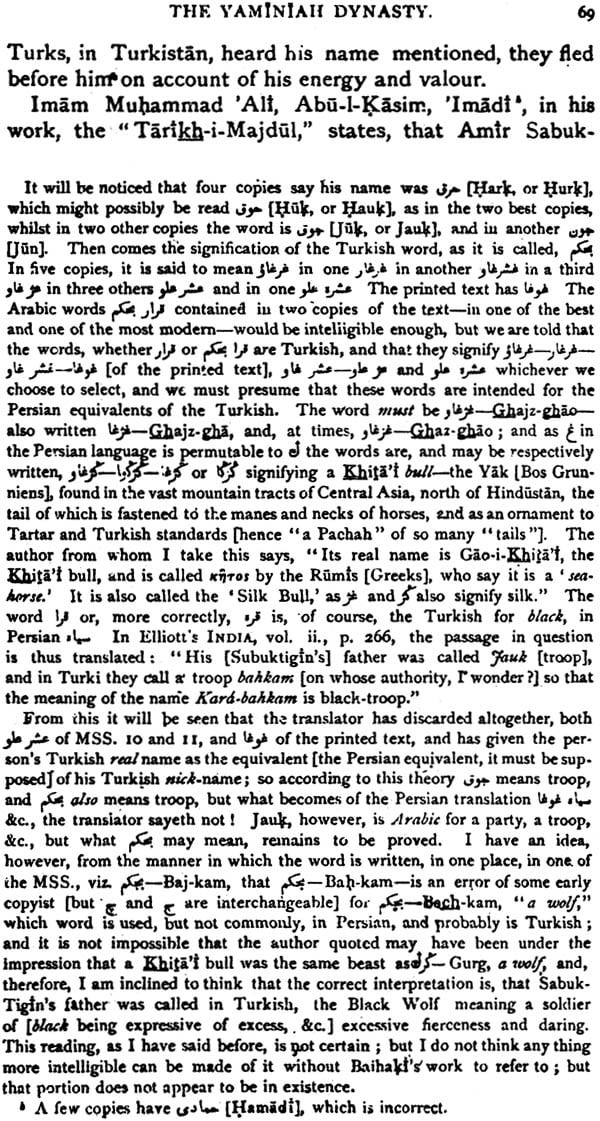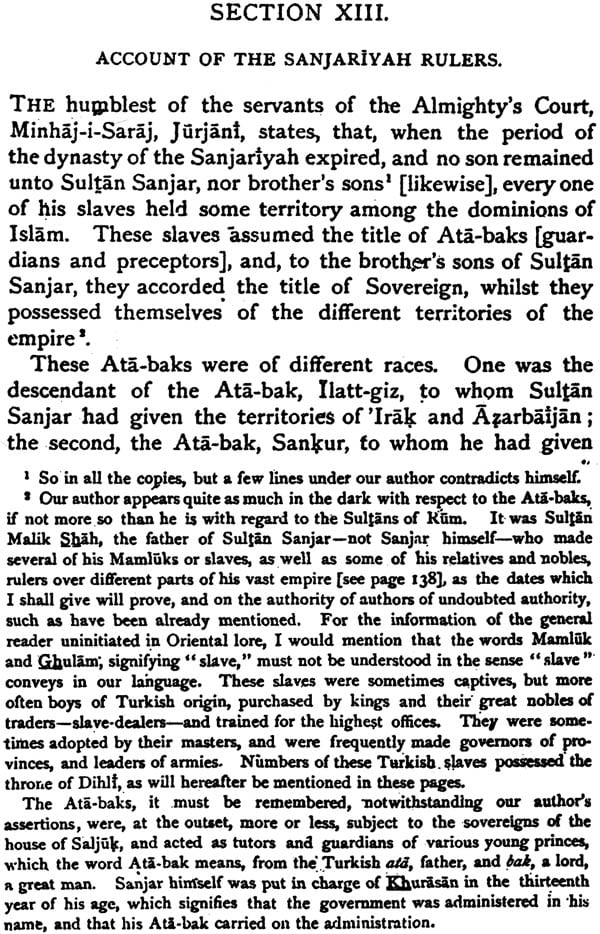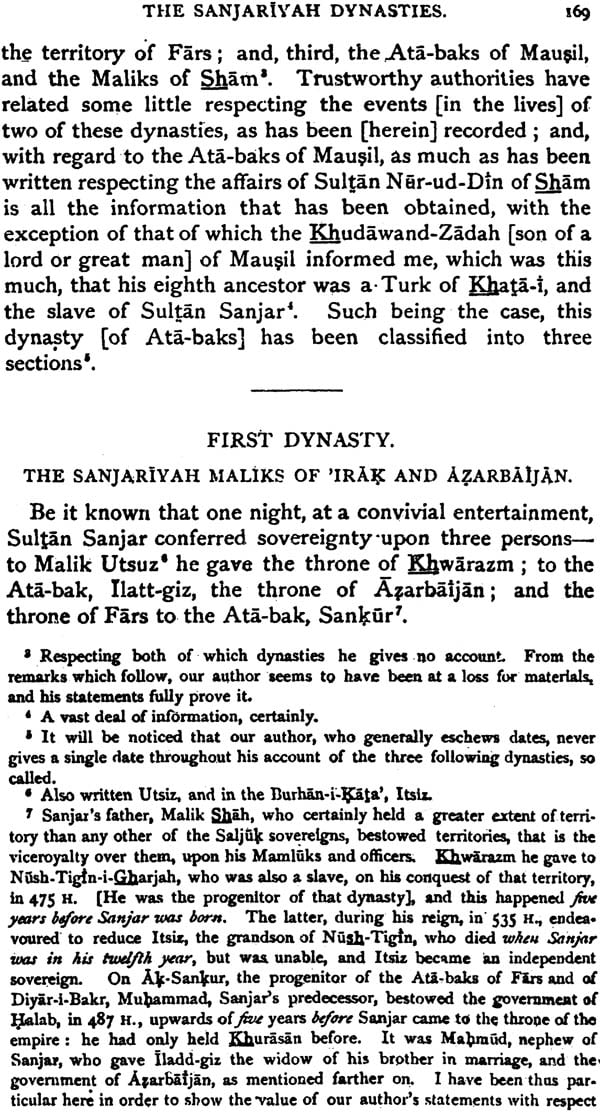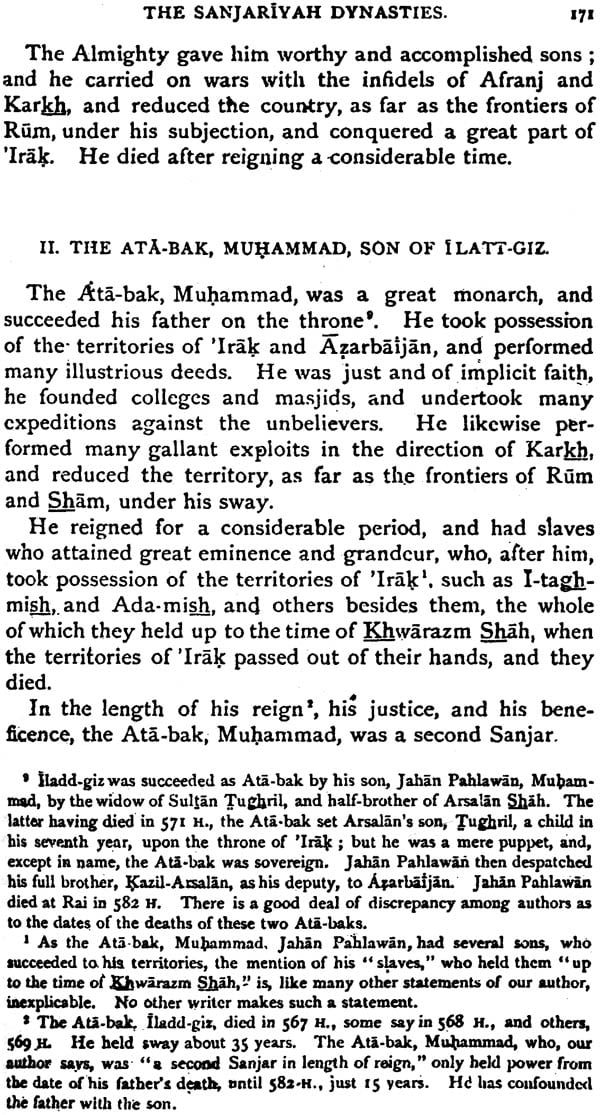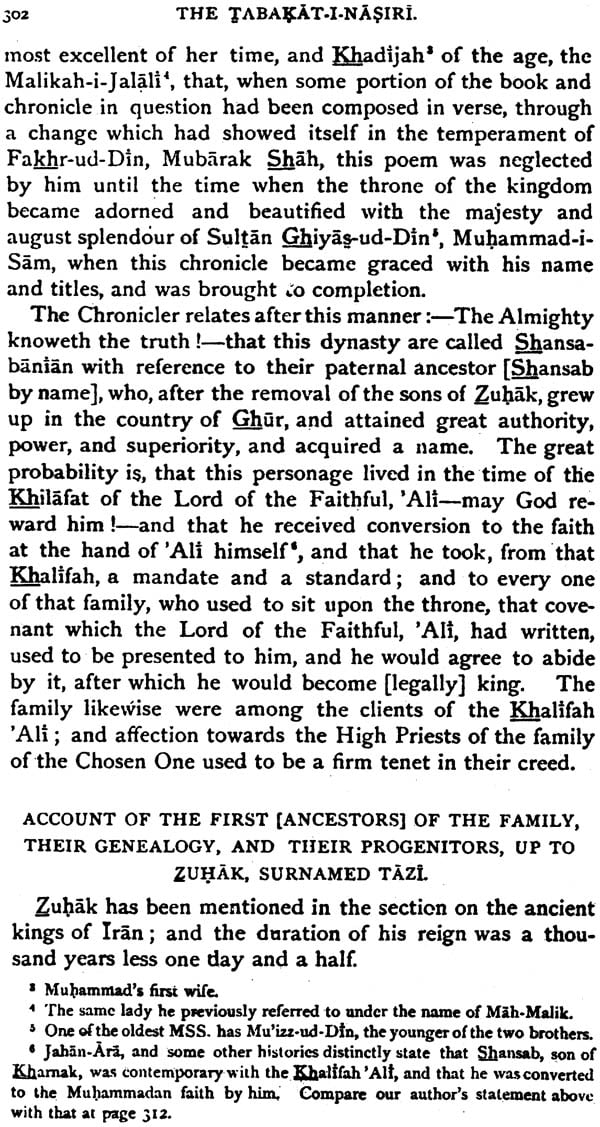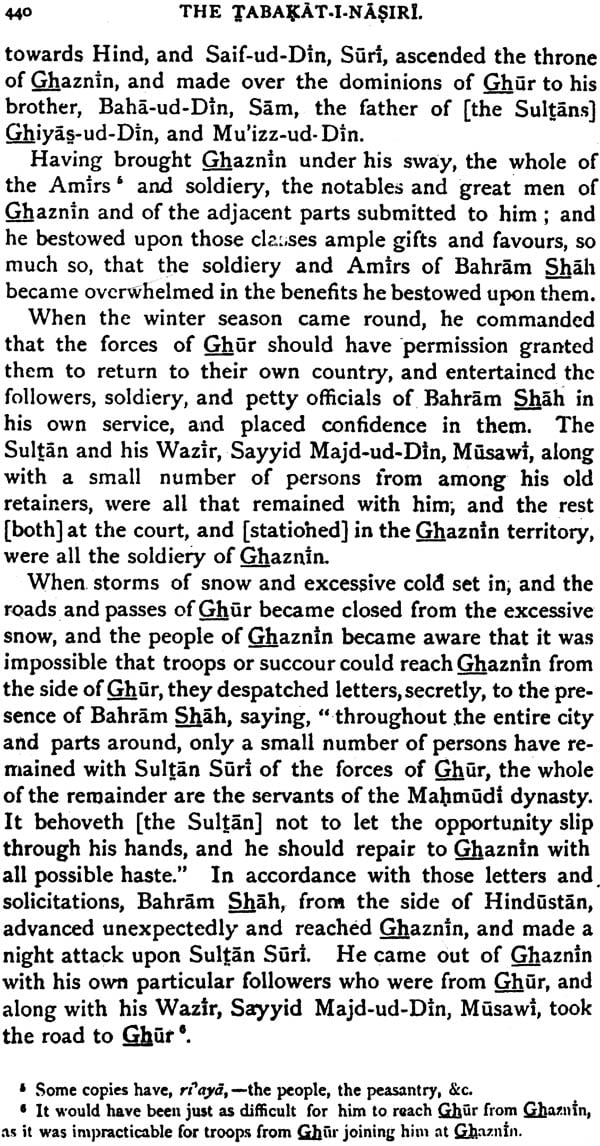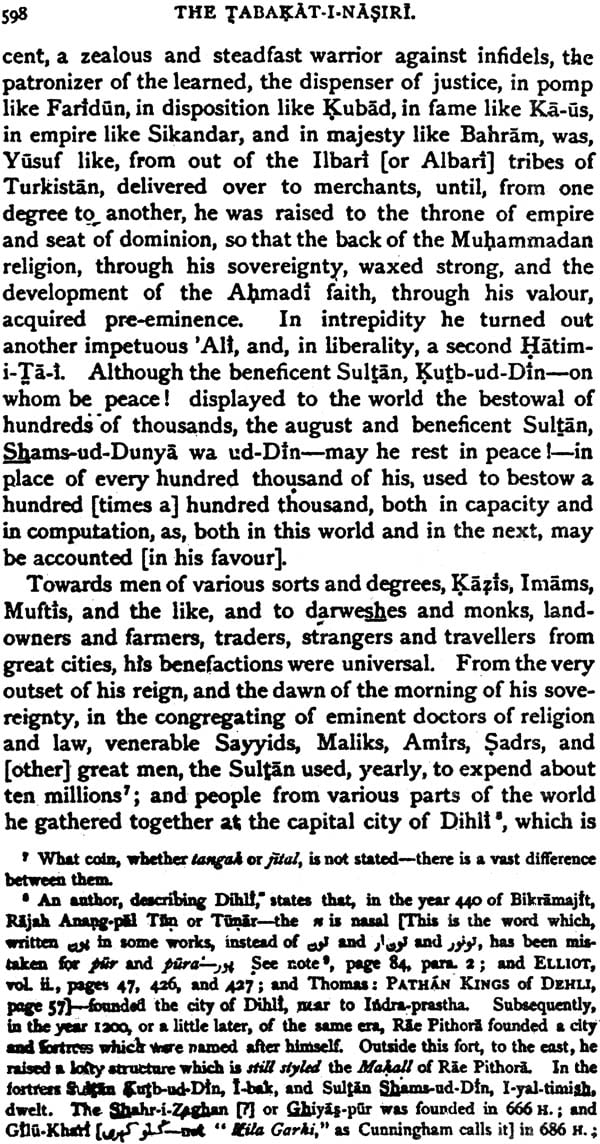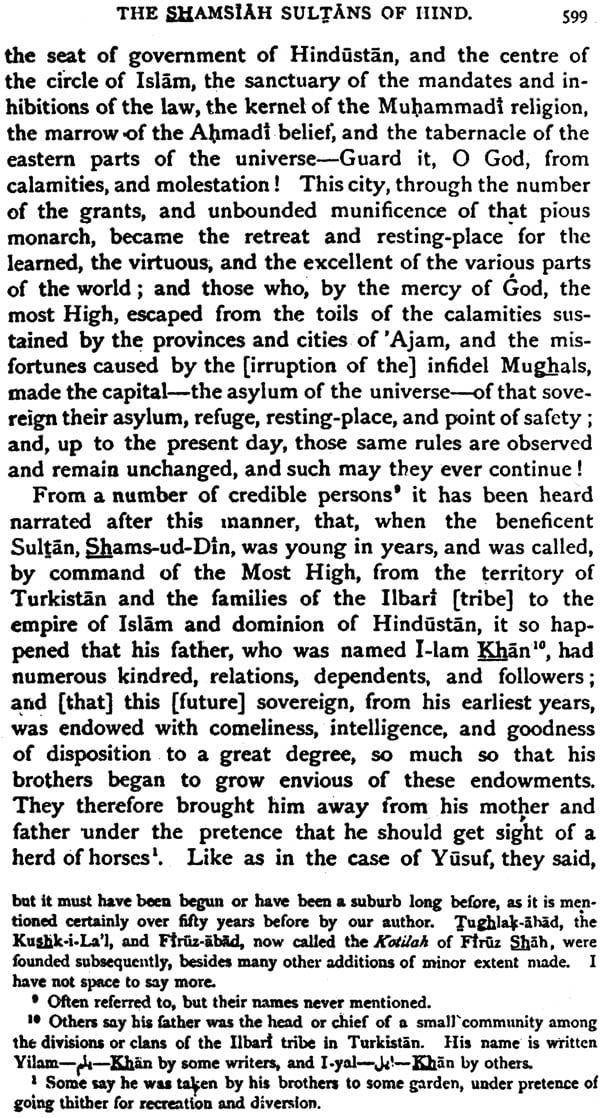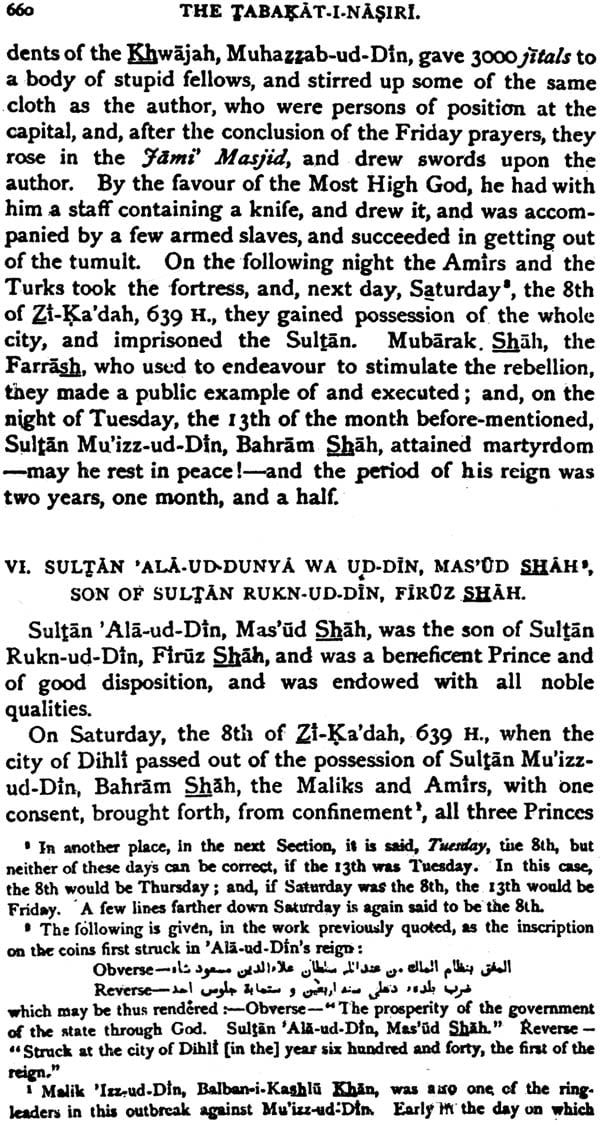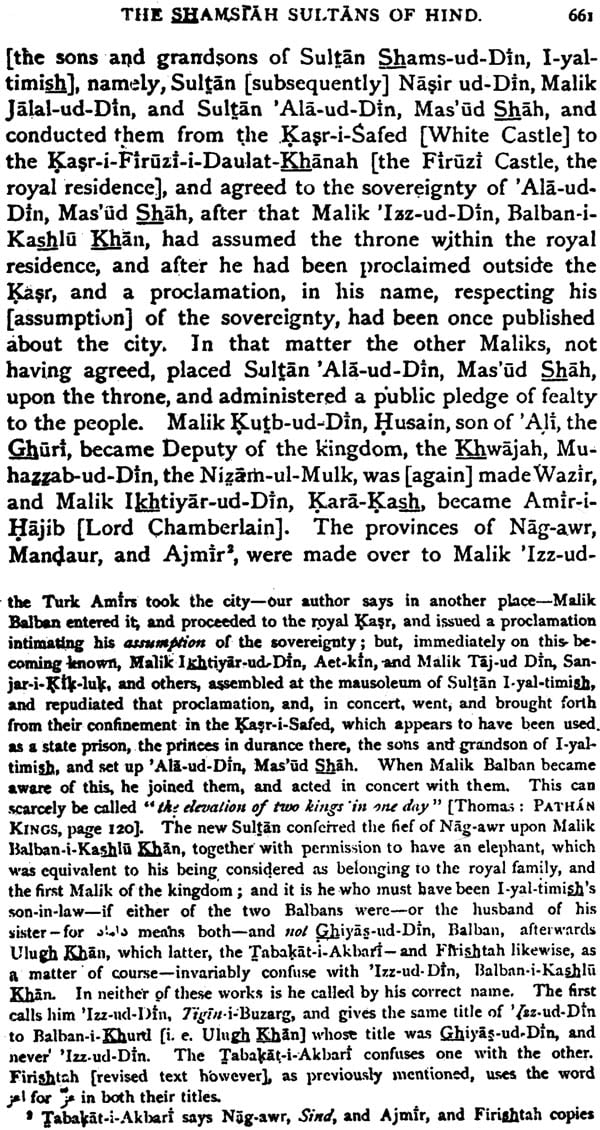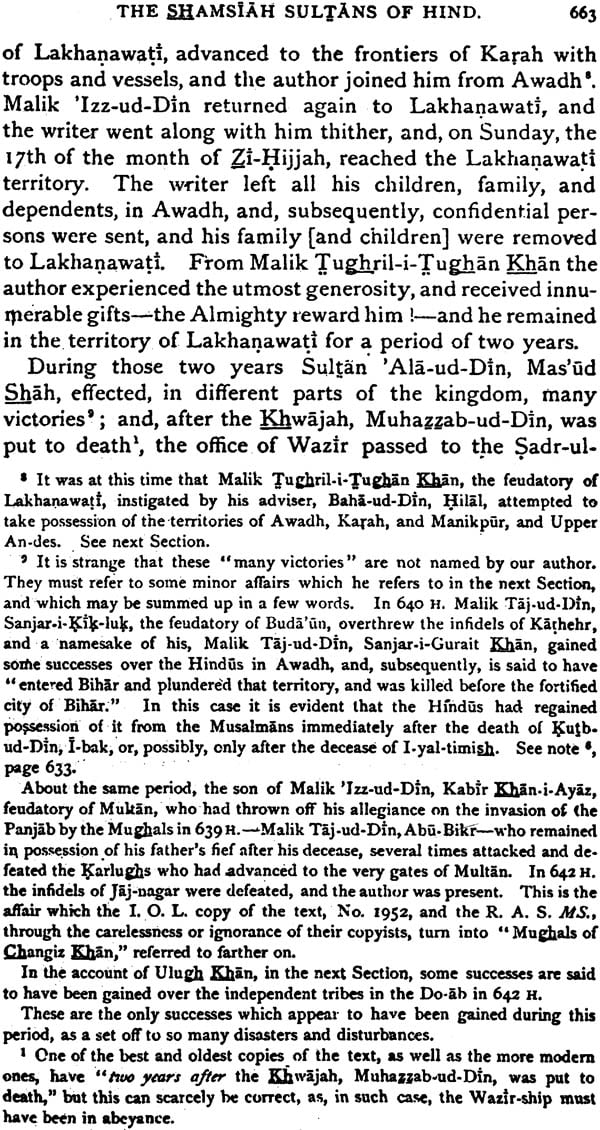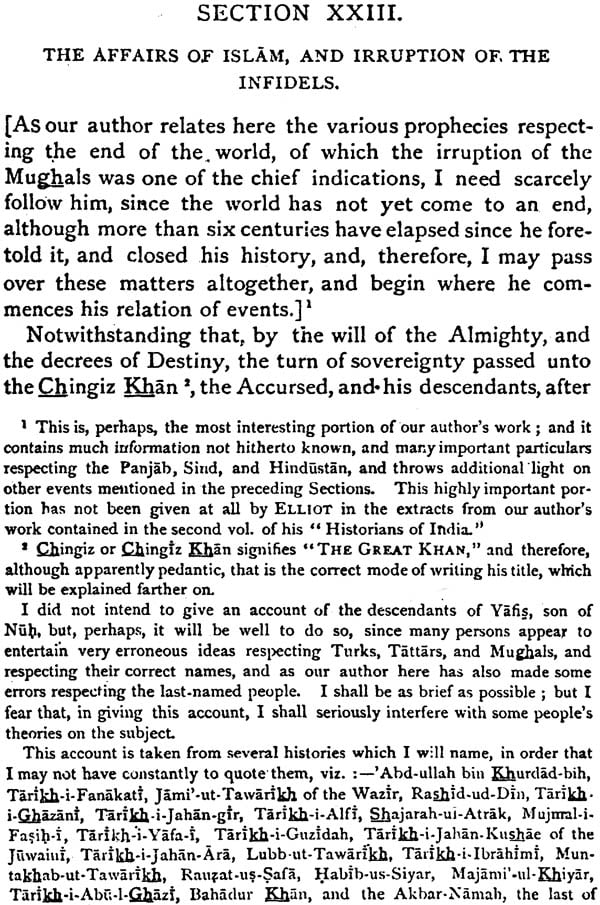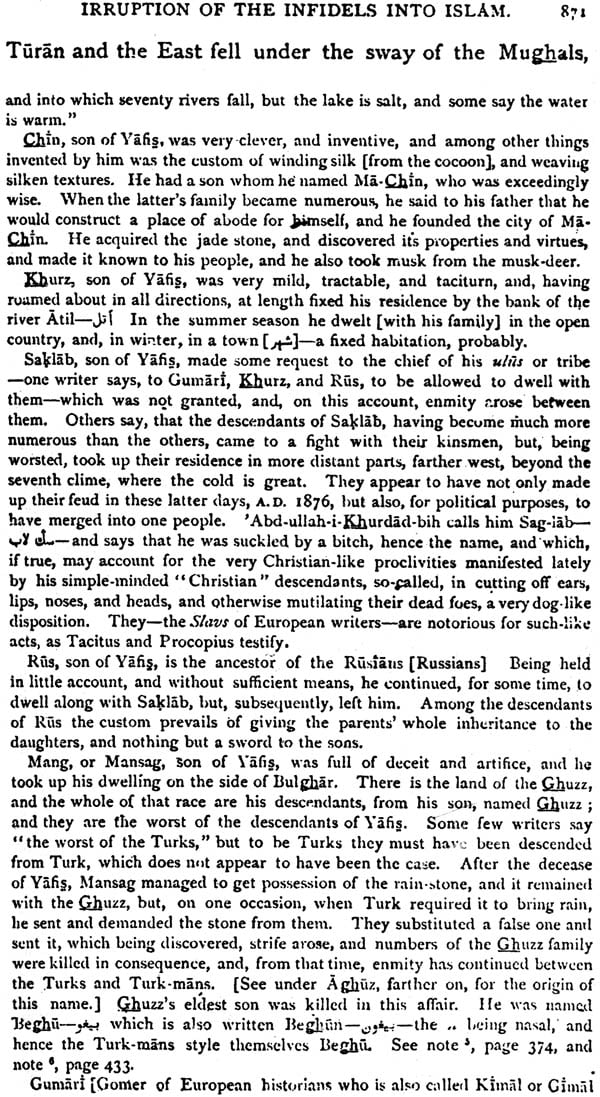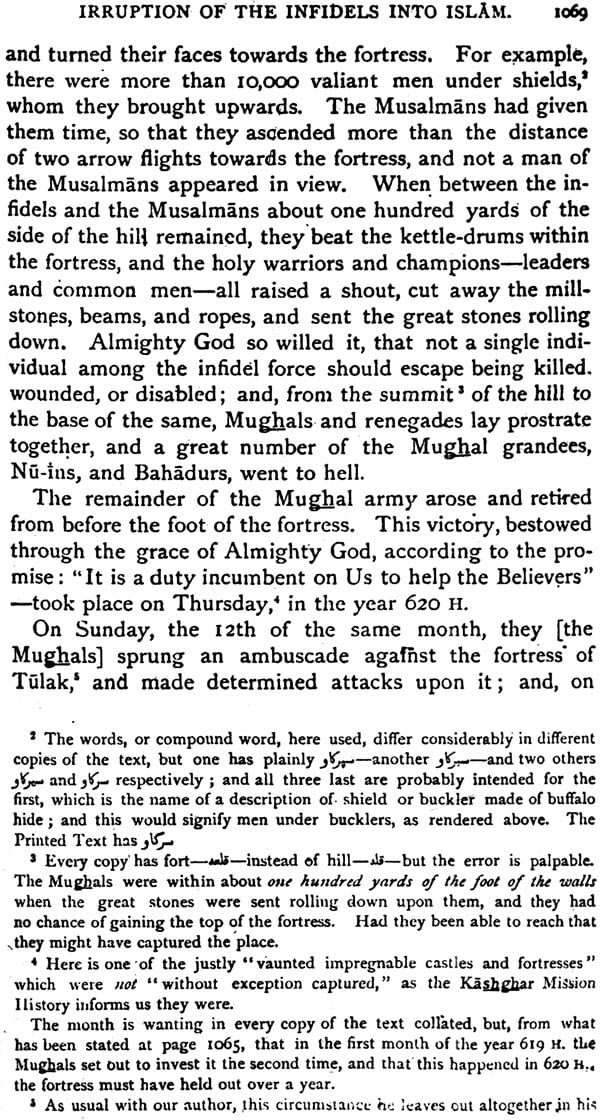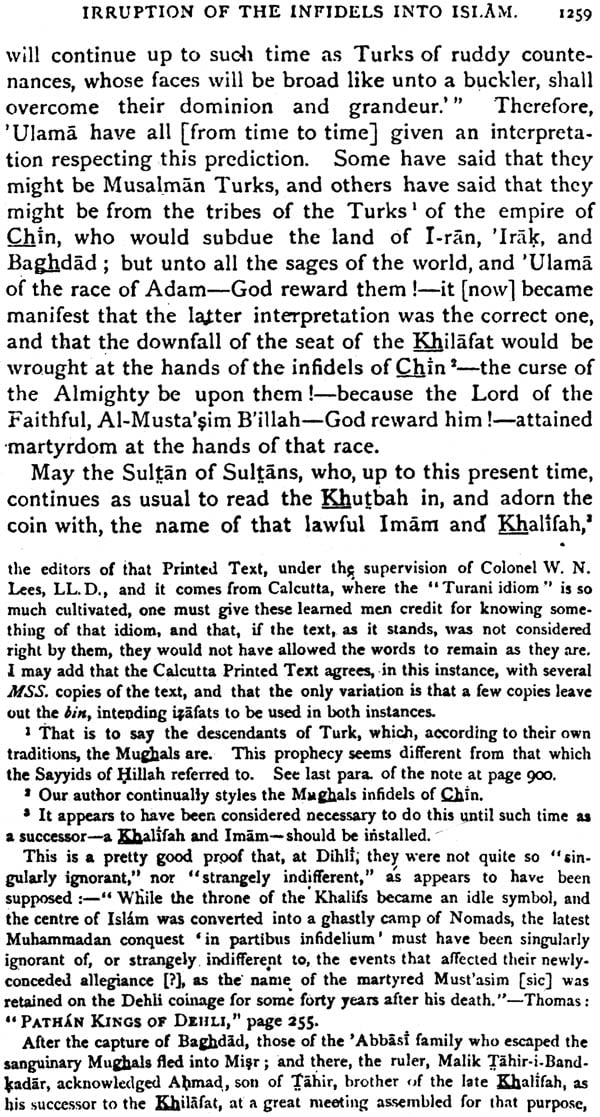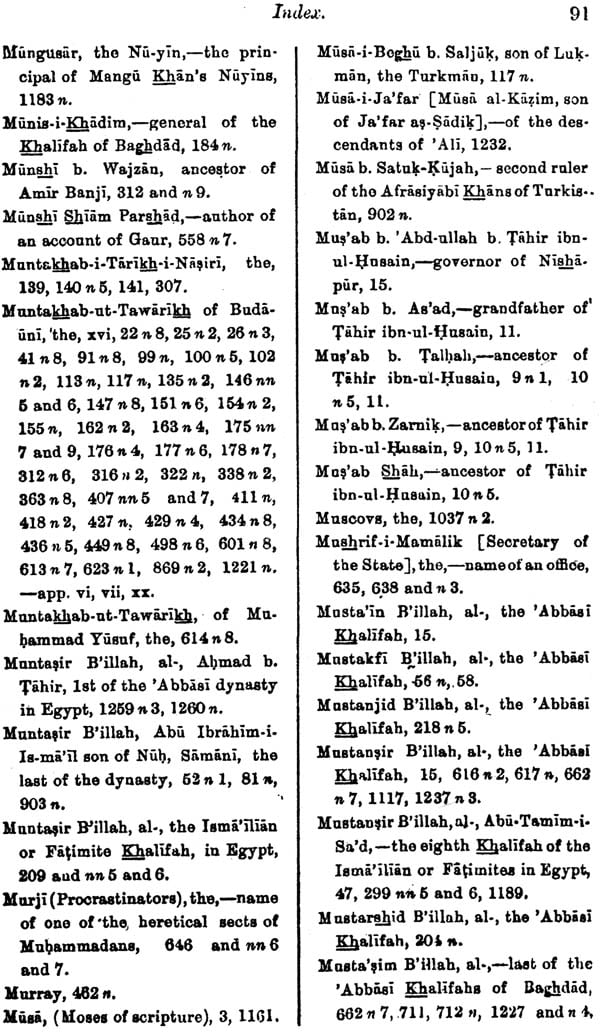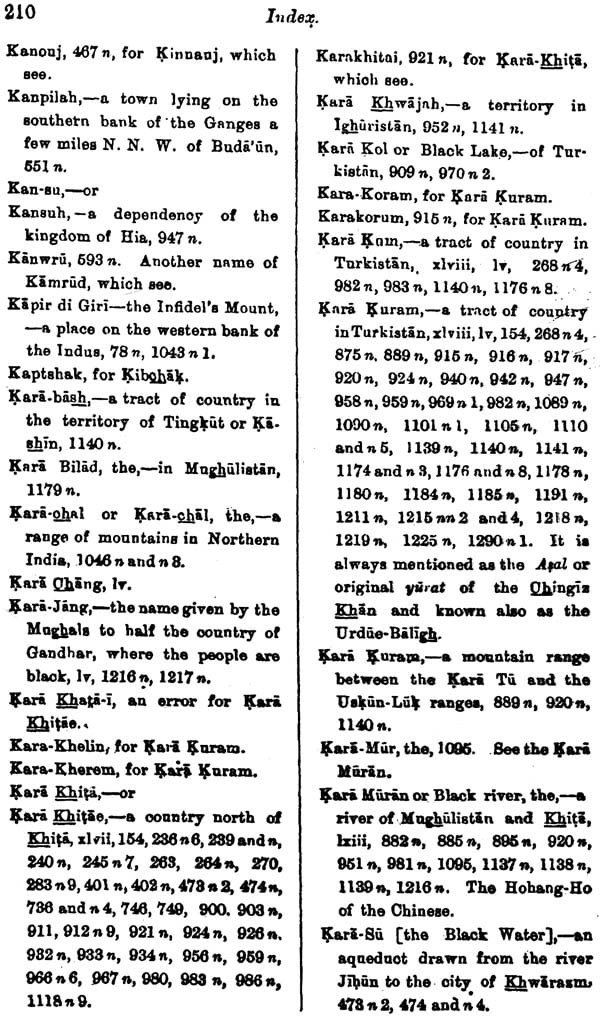
Tabakat-I-Nasiri: A General History of the Muhammadan Dynasties of Asia, Including Hindustan (In Two Volumes)
Book Specification
| Item Code: | NAB813 |
| Author: | Major H.G. Raverty |
| Publisher: | THE ASIATIC SOCIETY |
| Language: | English |
| Edition: | 2010 |
| Pages: | 1630 |
| Cover: | Hardcover |
| Other Details | 8.5 inch X 5.5 inch |
| Weight | 2.04 kg |
Book Description
Tabakat-I-Nasiri is a general history of the Muhammadan Dynasties of Asia, including India from 810 A.D. to 1260 A.D. by Maulana Mirhaj-Ud-Din, Abu-Umar-I-Usman. This was translated from the original Persian manuscripts by Major H.G. Raverty and the book was first published in 1881 in the Bibliotheca Indica series by the Asiatic Society of Bengal. This edition has been out of print for a long time and therefore the book is being reprinted by the Society. The text and the notes together may be considered as the repository of the “most varied and often recondite historical material” for the period between 810 and 1260 A.D. I sincerely hope that scholars will welcome this new edition.
IN 1865 I was led to read the printed text of the Tabakat- i-Nasiri, published at Calcutta in 1864, in search of materials towards a history of the Afghans and their country, which is very much mixed up with that of India.
Having gone through a great portion of it, and Ending it defective in many places, and full of errors, I thought it advisable to examine the India Office Library MS., No. 1952, from which the printed text was said to have been taken, went through the whole of that work, and found that it also was defective, and contained numerous errors. I found nothing, however, respecting the Afghans, except in' one place, and there they were briefly mentioned in a few lines, but very characteristically.
I had already discovered, when in search of other mate— rials, what lamentable errors the available Histories of India, so called, in the English language contained, and I now found how they had arisen. With a view of correcting them, I made a translation of those portions of the Tabakat-i-Nasiri which related to India, and the History of the Ghaznawi and Ghuri dynasties: and, when I offered a translation to the Bengal Asiatic Society some twelve years ago, my intention was, as stated in my letter on the subject, merely to have made a fair copy of the translation of those identical portions.
Soon after, I obtained a very old copy of the work; and, on comparing it with the I. O. L. M5. No. 1952, I found such considerable and important differences to exist, that I determined to begin anew, and translate the whole work. The Society having accepted my offer, and the defective, state of the printed text being well known, Mr. Arthur Grote, to whom I am very greatly indebted for assistance in many ways, advised that, in making this translation, I should avail myself of any other copies of the text that might be procurable in Europe. or instituting inquiry the following were found, and have been already referred to in my report to the Society, published in the “Proceedings " for February, 1873, and have been used by me in my task. I must here give a brief description of them, and notice and number them according to their apparent age and value, which arrangement, however, will be somewhat different from that in the notes to pages 68 and 77 of the translated text.
1. A MS. belonging to the St Petersburg Imperial Public Library.
This, probably, is the most ancient of the copies collated. It is not written in an elegant hand, by any means, although plainly and correctly, but in the style in which Mullas usually write. The dals are marked with diacritical points, and other letters are written in a peculiar manner, denoting considerable antiquity. It is, however, imperfect, and does not comprise much more than half the work.
2. The British Museum M S. No. Add. 26, 189. This copy is considered by Doctor Rieu, whose experience is sufficiently great, and authority undoubted, to be pa MS. of the fourteenth century. It is clearly written and correct, and has been of the utmost use to me. It wants a few pages at the end; hence the date on which it was completed, and by whom written, which generally are inserted at the end, cannot be discovered.
3. The old MS. in my possession.
To judge from the writing and paper, I should suppose it to be about the same age as No. 2. It is clearly written, but wants several pages at the end, consequently, the date of its completion likewise cannot be discovered. One pretty good proof of its age, however, is that the whole, from beginning to end, has been cut close to the illuminated borders of each leaf] and inlaid on other paper, which also appears to be of considerable age. Whoever did this turned a number of leaves the wrong way, and misplaced several pages, which took me some time to put in their places again.
I imagine that there is very little difference, in point of antiquity, between these three copies.
4. A MS. belonging to the Imperial Academy of Sciences at St. Petersburg.
This is a. well and correctly written M.S., which has also been of the greatest use to me in my work. It wants about two leaves at the end, and, consequently, the date on which it was copied does not appear. I should say, comparing it with the others above described, that it is a JMS, of the sixteenth century, possibly, still earlier. It has an unreadable name on the last leaf, with 1218 H. [1803 A.D.] upon it.
5. The India Office Library MS., No. 1952.
This is also a plainly written copy, and, apparently, of considerable age, nearly as old, possibly, as the three copies first named, but it is incorrect in scores of places ; one place in particular, where three complete pages of the history of Sultan Mas’f1d of Ghaznin occur in the middle of the ac- count of the Saljuks. This is important, although an error, because it shows us how many other copies have been taken from it, or that it, and the other copies hereafter to be named, were all copied from another, still earlier, MS. imperfect in that identical place.
This MS. is, in all probability, that referred to by Stewart, as belonging to Tipu’s library, and said to have been " copied by the author himself" The reason why this, too, has been erroneously considered " an autograph of the author’s” is simply this-whoever copied it, as in the case of other copies, neither recorded his own name, nor the place where, or date when, it was completed, and so it terminates in the author's own words, hence some people have run away with the idea—and it only shows upon what a shadow they often found their theories-—that the author himself must have written it. It ends. thus:—" The book of Al—Minhaj bin Saraj, the 5th of Rabi'-ul-Awwal—~the third month-in the year fifty and six hundred." The eight, which should have preceded the fifty, has been left out. On the first leaf the following is written: " The Tabakat- i-Nasiri, in the city of Haidar-abad, in the month of Rabi'-ul-Awwal, 1157 H. [1744 A.D], was bought of the booksellers in that place."
6 and 7. Two MSS. in the Paris National Library. These may be classed, at least the best of the two, with the preceding M S., No. 5,in point of date, and want of correctness; and I believe that they are either copies of N0. 5, or, like it and two others—the Bodleian MS., and the R0. Asiatic Soc. MS.—copies of the same identical MS. They all agree as to errors} and they all end in the same way, without the name of the scribe, the date, or place where copied, with the single exception of the Bodleian copy, which has the word " eight" written over the words " fifty and six hundred.” For the reasons above-mentioned, both Paris M.SS.—not one only, I find—were fondly considered " autographs of the author’s” but M. H. Zotenberg, whose opinion I asked, very justly says, “ this is impossible, because the two M S. are not in the same handwriting? He, how- ever, adds, " but to judge from the paper and the writing, I should suppose that they are both MSS. of the fifteenth century. They were. both brought from India." They came from the Dakhan, in all probability.
8 and 9. The other copy of the text in the British Museum, No. Add. 2 5,78 5, which Doctor Rieu considers may be of the sixteenth century, and another belonging to the Imperial Academy of Sciences of St. Petersburg. These are,’ comparatively, modem copies, of the first half of the seventeenth century in all likelihood. They are plainly written, but are neither of them very correct. The former is defective to the extent of seven or eight 8vo. pages at the end, and the other also wants a few leaves. They are neither of them of much value.
10. A AIS. Formerly in the Library of Haileybury College.
This is the most complete M S. of the text that I have met with, although it is of comparatively recent date. It is written in a plain, but not elegant hand. It is generally correct, and closely agrees with Nos. 2, 3, and 4; and I have found it exceedingly useful. Indeed without it, and Nos. 2, 3, and 4, I never could have completed my task satisfactorily. In a few places it supplied what was defective in two of the others. The date of copying is not given, but, from its appearance, I should say it was a MS. of the last half of the seventeenth century. After_ the author’s concluding words the following is written:— " The owner of this MS., in the port [Bandar] of Surat, [is] the Haji, Muhammad Tahir] son of Mulla Muhammad Sharif, son of Mulla Muhammad Tahir; "after which follow some words not quite intelligible, “ on the 8th of §_ha’b5n— the eighth month— 1113 H. [1 701-1702, A.D.], was recorded." The two last words appear to refer rather to the date the owner wrote his name, than to the date the M S. was com- pleted. It subsequently belonged to some Grandee of the Mughal empire, from the titles given under the above record, namely, " The Mumtaz-ud—Daulah, Mufakhkhar ul- Mulk, Husam-i-Jang."' Who he was I am unable to say.
II. The copy of the text formerly belonging to the late Colonel G. W. Hamilton, C.B., in the collection of the late Earl of Crawfurd and Balcarres. This is, upon the whole, the worst copy I have collated, and contains very numerous errors, although, in point of age, it may be older than Nos. 8,9, and 10. It terminates abruptly at page 462 of the Printed Text, and is thus defective to the extent of about twenty- six pages, but it has the closing page, and when and where written. Before I saw it, I was informed that it was a very valuable copy, and that it had belonged to " the Emperor Shah Jahan, because his seal was stamped on the margin of one of the pages." On examination, I found that the MS. was completed " on Thursday, the 6th of Rajab—the seventh month—of the year 1059 H. [July, 1649], in the reign of the Second Sahib-i-Kiran, Abu—l—Muzaffar, Shihab- ud-Din, ’Muhammad, Shah-i-Jahan, Badshah-i-Ghazi, in the city of Burhanpur [in Kandes], at the time when hostilities broke out between that monarch and Shah 'Abbas the Second [the Safawi ruler of I-ran],. Respecting Kanda— har [the Kizil-bashis were then actually investing that stronghold]," and that the copyist was the Khanah-zad-i- Dargah [the born slave of the Court or Household], Mu’in- ud-Din, Khwajah-i-jahan, the Jahan-giri," [of the Household of Jahangir Badshah], Shah-i-Jahan Badshah’s father.
Beneath this again is the name of a Maulawi, the son of some "Khan," partly obliterated, with the date 1255 H. [1839 A.D.]. A seal underneath bears the date 1233 1•1. [1818 A.D.]. The largest seal, supposed to be that of Shah-i-Jahan Badshah, bears the following inscription:— "Mu’in-ud-Din, Muhammad [the same person as referred to above], ghulam-i-Shah—i-Jahan," with the figures 24, referring to the year of that mo11arch’s reign, and the year 1061 H. [it began Dec. 14th, 1650, A.D.]. A smaller seal, with an inscription-" Ya Mu’in "——" O Helper!"-bears date 1058 H. [1648 A.D.]. I could discover nothing to show that the MS. had ever belonged to Shah-i-Jahan Badshah. 12. The M'5. Belonged to the Royal Asiatic Society.
This, as previously mentioned, is a modern copy, of the latter part of the seventeenth century possibly, and is either a copy of No. 5, or copied from the same MS. that that was copied from. It is pretty plainly but carelessly written, in, by no means, a good hand; but, like the others referred to, is very defective, and the proper names of persons and places are often without any points.
I have already noticed how incorrect the Printed Text is. In the Preface to it, Colonel W. N. Lees, LL.D., says: “When I commenced the work, we had three copies, one belonging to the Ro. Asiastic Soc., one in the India House Library, and one belonging to the High Priest of the Parsis at Bombay. A little while afterwards, Colonel Hamilton, in reply to a circular of the Society, forwarded a copy from Delhi. These MSS. are all apparently good old copies, and are written in very different hands; It was supposed, then, that we had four distinct copies to collate ; but, before long, it became apparent that the four had been copied from two MISS.} so, in reality, we had only two .... The Society had issued hundreds of circulars to all parts of India, and had failed to draw out more than two copies; and the fact, that the four old copies I had had been copied from two MSS., seemed to indicate so clearly the great scarcity of MSS. of this work, that I decided to go on." From these remarks its defectiveness is not to be won- dered at, but, at the same time, as I have shown in my notes, there are numerous errors in it which are not to be found in these MSS., and a little historical and geographical discrimination on the part of the editors might have corrected many of them.
The time and labour required for simply translating a book, especially if but one or two copies be used for collation, is not very great; and this translation could have been accomplished in a tithe of the time I have devoted to it. But, as this History is one of the four most important works with respect to the early rulers of India, and that part of Central Asia upon which all eyes have been lately turned, and are likely to be turned in the future, I thought it advisable not to spare any pains on it, although it has occupied some years longer than I anticipated. I have collated nine copies of the text word for word; and all doubtful passages have been collated for me from the other three. Although this has occupied a great deal of time, and entailed much labour, a still greater amount of both has been expended on the notes, which I deemed necessary to illustrate our author` s often brief, sometimes erroneous, but generally valuable, statements, to point out the errors which he has sometimes fallen into, and to point out some of the legion of lamentable mistakes, and misleading statements, contained in compilations purporting to be "`Histories of India," "Histories of Afghanistan from the Earliest Times," and similar Histories of other Eastern states and peoples ; and to show the exact value of the compilations, turned out by the yard by raw hands, for the Public of the news- papers and reviews, and the general reader.
These errors in Indian History are solely attributable to the miscalled translations of the comparatively modem chronicle, known as the Tarikh-i-Firishtah by Dow and Briggs, the first of whom could not possibly have under- stood the words of the writer in scores of places, and in such cases appears to have recorded his own ideas instead of the author’s statements. Firishtah’s work, too, is not difficult, and the style is simple; and it is one of a few books well adapted for the Lower Standard of Examination in the Persian language. Firishtah’s materials were chiefly taken from the Tabakat-i-Akbari, also known as the Tabakat-i-Akbar Shahi, of the Khwajah, Nizam-ud-Din, Ahmad, who obtained his materials, up to the reign of Ghiyas-su-Din, Balban, from the work of our author; and not a single event is recorded in Firishtah that is not recorded in the Tabakat-i-Akbari. This will be quite clear to any one who will take the trouble to compare them. A Firishtah, indeed, follows it so closely that, not only are the poetical quotations appropriated, but the errors also, as I have pointed out in my notes, have been faithfully copied by the Dakhani author: where the one errs the other is sure to follow.
The English version of Briggs, "the admirable version," as a writer, who did not know the contents of Firishtah, calls it, is clearly based upon Dow's, with very slight alterations, and they are chiefly of a verbal kind. I should be sorry to be unjust to any author, but I submit that, where great, misleading; and glaring, historical errors, are as clear as the light of day, it is a duty towards the public, and in the interests of science, that they should be pointed out, even at the risk of " hurting the susceptibilities" of the authors of them or their friends, especially when such pernicious compilations as I have referred to, under the name of history, continue to be used in our colleges and schools, without the nature of them being known in its true light. The writers of them have much to answer for, but those who have adopted them in our public institutions a vast deal more. See, for example, note ‘, page 312, and note, page 323.
One of the most glaring of the misstatements I refer to is that wherein the Turk sovereigns of Ghaznin, as well as the Tajzik rulers of Ghur, are turned into "Pathans" or "Afghans," which words are synonymous, and "Pathans" or "Afghans” into Turks and Tajzik Ghuris. Dow, in the first place, is to blame for this, but Briggs blindly followed him ‘I say this advisedly. The proof is easy from any MS. of Firishtah’s _work, but with MSS alone we need not rest content. We have only to compare Briggs's version with that lithographed edition printed at Bombay, to which Briggs put his name as editor and reviser, to prove my words.
Let us, for example, take any passage in Briggs’ account of the Ghuris, or the history of the Turkish slave Sultana of Dihli—those, say, referred to at page 508 of this work —and in the Persian text which, according to the title- page, had the benefit of his editing and revision, not one: ward will be found respecting their being Afghans, as contained in his " admirable translation:" all comes from Dow.
If this Translation of the Tabakat-I-Nasiri, the original of which was published just six hundred and twenty- one years ago, and the notes accompanying it, disperse to the winds this error-bubble alone, I shall deem my time not lost, and the labour of years not thrown away, because, even since the publication of Sir H. Elliot’s extracts from various Histories, which also showed; how incorrect this "Pathan’ theory was, Turks, Tajzik Ghuris, Turkish Slaves, Jats, Sayyids, and others, continue to figure under the ridiculous name of " Pathan dynasties," up to this present day.
I have already remarked that our author has mentioned the Afghans but once in his History, and that very briefly, but, at the same time, most graphically [page 8 52], a body of them • being in the pay of the Ulugh Khan-i-A’zam. The Afghans were by no means unfamiliar to our author, and he certainly knew the Ghuris better than any other author known to us, and he shows on that very page that they were a totally different race. In his account of the Shansabanis of Ghur, and their dynasties, he simply stands unrivalled, and also in his accounts of the first Mughal invasions of the territories between Hirat and Multan.
The Afghans appear at this time to have begun to take service under the-Muhammadan feudatories of the western border provinces of the, Dihli kingdom. They may have been in the habit of taking such service previously, but to no great extent I imagine, but, about this period, there was a particular reason for it—the confusion and convulsions caused through- out the vast tracts of country which formed the kingdom of the Ghaznawis and their subverters the Ghuris, styled Afghanistan by Europeans chiefly, through the irruptions, devastations, massacres, and final subversion of the Musalman rule by the hordes of infidel Mughals, by whom the country of the Afghans was completely surrounded on the north, south, and west, while the only territory still held by a Musalman sovereign lay on the east—the Panjab-the western part of which also subsequently fell under the Mughal yoke. The limits of the true Afghanistan were pre- scribed by the mountains bounding the Kurma'h valley and the territory of Kabul on the north, the Koh-i•Surkh on the south, the territories of Ghaznin and Kandahar on the west, and the Sulimani mountains or Koh-i-Siyah on the east.
It will be observed that I have really commenced the Translation from Section VII.; and from that point it embraces the whole work. The first six, with the exception of the History of the early kings of I-ran, are not of much importance by reason of their brevity. The account of the I-rani dynasties, which would require a volume to illustrate them, I have treated as a separate work, which, ere long, may see the light. To make the Translation in effect complete, however, I have given an abstract of the first six Sections.
The adulations addressed to, and constant prayers offered up for, the Sultan to whom the author dedicated, and after whom he named, his History, have been omitted or greatly reduced, and some of the introductions to the Sections also, which are of a similar style, have been cut short, but, in all other cases, I have not "compressed" the Translation in the least degree; and I may say that I have weighed every word and sentence, and have omitted nothing, not even the poetical quotations, having only rejected some of the longer portions when they have been of no interest, not necessary to the text, or of no particular merit. I have endeavoured to render the translation as nearly as possible in the author’s own words, without being slavishly literal. It is however sufficiently literal to assist a student, and yet readable by the English reader, though keeping much of a foreign complexion for various reasons. It is possible that in so long a work, published at intervals as completed, and not in a complete form at once, slight inconsistencies in punctuation and English (though not Persian, save through printers} errors) orthography may be here and there observable. Most English punctuation is haphazard, and left to the compositors, who, apparently, sometimes use it to denote breathing pauses; sometimes to help out the grammar.
One may point sentences very much or very little, but whatever is done should be upon one system. Accordingly here, for the most part, the minute plan of what may seem to some over much stopping is adopted, though not always, but no such absurdity is allowed to appear as a divorce of the verb from its subject by a single comma, and other errors of that sort, which come of printers attending entirely to pause and forgetting grammar.
Scholars will understand that there may be much to be said for more ways than one of spelling the same word in such a language as English.
This book, the text and notes together, will be found to be a very thesaurus of the most varied and often recondite historical material for the periods of which it treats, and many time-honoured historical errors have been pointed out and rectified. It wants but one thing to make it still more accept- able to the Student, and that is an Index. The Reviewers are tolerably sure to point this out for fear nobody else should see it. So the Translator begs to say, once for all, that he is too weary, and his time too valuable, to take up any such work. Meanwhile, The Index Society will have here a capital tough subject for their charitable exertions.
| Foreword | iii | |
| Preface | v | |
| Memoir of the Author | xix | |
| Author’s Preface and Dedication | xxxi | |
| Contents | xxxv | |
| Additional Notes and Emendations | xlv | |
| Errata | lvii | |
| Introductory, being an Epitome of the First Six Sections | 1 | |
| Section I | Adam, the Patriarchs and Prophets, and the ancestors of Muhammad | ib. |
| Section II | The Four orthodox Khalifahs, the descendants of Ali, and the Comparions of the Prophet | ib. |
| Section III | The Khalifahs of the house of Ummiyah | ib |
| Section IV | The Khalifahs of the house of Abbas | ib |
| Section V | The Maliks of ‘Ajam to the rise of Islam:- | |
| Section VI | The Tubba-yawa, and Malika of Yaman | 6 |
| Section VII | The Dynasty of the Tahiri Muhammadan Maliks in ‘Ajam | 9 |
| Section VIII | The Suffarium Dynasty | 19 |
| Section IX | The Dynasty of the Samanis | 26 |
| Section X | The Dynasty of the Dialamah Maliks at the Dar-ul-Khilafat of Baghdad, and in ‘Irak | 55 |
| Section XI | The Dynasty of the Yaminiah, Al-Mahmadiah Sovereigns of the race of Sabuk-Tigin | 67 |
| Section XII | The Dynasty of the Saljukiah | 116 |
| Section XIII | Account of the Sanjariyah Rulers | 168 |
| Section XIV | The Maliks of Sijistan and Nimroz | 183 |
| Section XV | The Kurdiah Maliks of Sham | 203 |
| Section XVI | The Maliks of the Khwarazm-Shahiah Dynasty | 231 |
| Section XVII | The Shansabaniah Sultans, and the Maliks of Ghur | 300 |
| Section XVIII | The Shansabani Sultans of Tukharistan and Bamian | 421 |
| Section XIX | The Sultans of Ghaznin of the Shansabaniah Dynasty | 438 |
| Section XX | Account of the Mu’izziah Sultans of Hind | 508 |
| Section XXI | The Shamsi Sultans of Hind | 596 |
| Section XXII | Account of the Shamsiah Maliks in Hind | 719 |
| Section XXIII | The Affairs of Islam, and Irruption of the Infidels | 869 |
| First statement | 1287 | |
| Second statement | 1290 | |
| Conclusion | 1293 | |
| Appendix A | i | |
| Appendix B | vii | |
| Appendix C | xiii | |
| Appendix D | xxiii |


